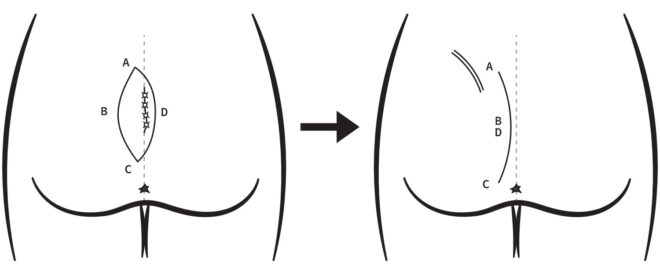Pilonidal sinus is a benign disease in which a hole occurs in the midline above the buttocks. This condition is found in males six times more common than in females. This disease often takes a chronic course that may cause long term annoyance and disability in youngsters and adults. It mainly affects intergluteal furrows and other specific areas rarely defect.
Even today, the treatment of this condition is controversial. Out of many procedures, techniques, and surgeries available to treat this disease, the most commonly used technique, is named the Karydakis flap. It is the lateralization of the scar with the help of an asymmetrical flap closure, after the removal of the sinus.
The above mentioned was just an abstract. All the other relevant details are mentioned below. So, to get yourself familiar with this treatment, you must continue reading further.
What is the Karydakis flap?
Karydakis flap is a procedure for treating a disease named pilonidal sinus. A pilonidal sinus is a tunnel or a hole that forms in the skin in the split area above the buttocks. This hole can be filled with pus or fluid that may lead to the formation of a cyst. This pilonidal cyst is extremely painful because it consists of dirt. This disease mostly occurs in males who lie between the ages of 15 to 35 years old. Also, this condition often occurs in those people who have deep indigenous cleft and short dark hairs. So when this cyst occurs, then, the surgeons use this treatment named Karydakis flap to treat these painful cysts.
Karydakis flap Technique
Karydakis flap is a technique, which was first discovered by a Greek surgeon named Dr George Karydakis. This technique involves the removal or elimination of the abscess or pus from the hole present above the buttocks. In other words, Karydakis is a simple technique of lateralization of the wound with the help of an asymmetrical flap closure after the removal of the sinus or cyst. After creating an asymmetrical flap across the intergluteal furrow, the furrow becomes shallow and the scar goes away from the midline. Also, this technique appears to be associated with low morbidity and lower chances of recurrence.
Karydakis flap Healing time
The healing duration depends on the patient’s condition, but, most commonly, the people treated with this technique are recovered within two weeks. After this surgery, most patients are discharged on either the 3rd or 4th day. The suction drain is taken out after 1-2 days, and the sutures are removed after ten days.
Karydakis flap Procedure steps
The procedure of this technique begins with the creation of an asymmetric flap across the intergluteal furrow that makes the furrow shallow and moves the scar away from the separation line of buttocks. Now an asymmetrical elliptical cut, which is about 5cm in length, is made around the sinus. The whole ellipse containing the sinus tract is excised that moves down to the sacrococcygeal fascia. Each end of the incision is at least 1.5-2 cm away from the midline.
The medial flap, close to the midline, is undercut to a distance of 2cm and at a depth of 1cm from the skin. The goal is to produce a thick flap that will cover the whole area of the wound cavity. A layer of interrupted absorbable stitches is placed on the surface under the flap. The other end is passed out and across the sacrococcygeal fascia at the other end of the base of the cavity. The flap is then pushed across the lateral edge of the wound, and then, with the help of the thumb of the assistant, it is held in place.
On the other side, the deeper stitches are tied to secure the flap at its depth. Now to protect these sutures, a suction tube drain is placed over them, and the edges of the skin of both the flaps are covered with either clips or 00 nylon stitches. After this whole procedure, care is taken so that no suture holes, drain holes, or any part of the wound is left close to the midline. The final suture line is away from the midline groove, which is flattened as a result of flap positioning. At last, a well-padded dressing is applied.
Karydakis flap Complication
The most common complications that occur during this treatment in few patients are, wound infection and serious wound collection. Therefore, such patients are recommended by the doctor to stay in the hospital for a more extended period.
 Health & Care Information
Health & Care Information 


